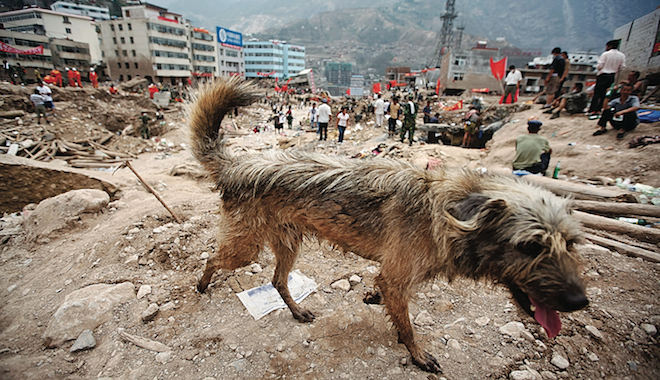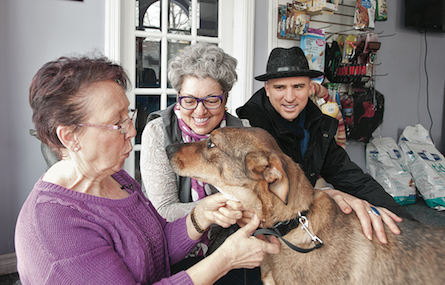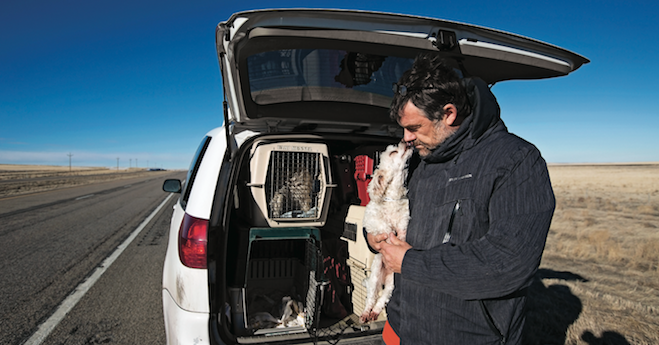How Canada became a haven for the world’s unwanted dogs
Thousands of international strays are finding a new home in Canada
Share

His story begins in a phone booth—or, more accurately, under it. The puppy had pawed out a refuge from spring monsoons and lay mewling as shoppers in Mussoorie, a mountain town north of New Delhi, passed him by. The wails of stray dogs are part of India’s sonic wallpaper; an estimated 250,000 roam the streets of Delhi alone, yipping and howling amid the din of car horns and motorcycles. But after several days of listening to this one, a group of schoolboys decided they’d had enough. Wary of the animal’s fleas and mange, they gathered him into a section of newspaper and prepared to throw him over a nearby cliff.
Barb Gard was not a rescuer in those days. She’d come to Mussoorie in 2003 to teach a session at its famed international school for girls and was booked to fly home to B.C. in two days. But she’d heard the pup on her walks to the town’s open-air market, and now, with the life of one bedraggled canine hanging in the balance, she decided to act. Advancing on the boys, she held out her waterproof jacket and—ignoring their warnings that the dog was dirty—wrapped him up and spirited him away.

Ten years on, that dog sprawls on Gard’s bedsheets in Abbotsford, B.C., a portrait of health and tranquility. His name is Francis, after the patron saint of animals, and his life story is only slightly less remarkable than the Assisian friar’s. After 24 hours on an electrolyte-heavy formula, a de-worming, a de-fleaing and a battery of shots at a local vet clinic, he was tucked into a crate for a two-stop flight to Canada, with Gard as his escort. In Singapore, airline officials paged her to the tarmac to calm her screeching animal and contend with his diarrhea. “By the time we got to Vancouver,” she recalls, “he was screaming so loud, they waived the inspection fee.”
A dreadful odyssey, in short, but one that changed Gard’s life. In 2006, she returned to India and brought home five more of the ubiquitous street dogs, known as “desis,” finding adoptive homes for them once she got back. During a third voyage in 2009, she partnered with a pair of activist veterinarians in Delhi to create a non-profit called Adopt an Indian Desi Dog (AAIDD). Gard, now a retired school psychologist, has since airlifted another 219 canines facing near-certain death from disease, starvation or euthanasia, and found most of them permanent homes in B.C. by advertising them on the adoption website, Petfinder.com. In 2011 alone, she brought 100 into the country, promising herself she’d scale back the airlifts because she’d worn herself out. Then, a few weeks before Christmas this year, her phone rang again. “I brought in another seven in January,” sighs the 58-year-old. “I couldn’t resist.”
Somehow, without notice, Canada has become a refuge to the huddled masses of the canine world, as thousands—perhaps tens of thousands—flood into the country each year. It’s a Wild West sphere, with no one tracking the number of rescuees entering the country, nor their countries of origin. The Canadian Food Inspection Agency (CFIA), which regulates the importation of animals, has recorded a spike over the past five years in the number of adult dogs imported annually for commercial use, from 150 to 922 (some rescued dogs are included in the “commercial use” category because organizations collect adoption fees to offset costs). But that represents a fraction of the inflow, because some rescuees enter the country designated as pets rather than commercial-use animals, and because border officers don’t keep count of the dogs they inspect for proof of rabies and for general health. One Calgary-based agency contacted by Maclean’s, Pawsitive Match Inc., says it trucked in about 800 dogs from the southwestern U.S. and Mexico in 2012 alone. It continues to receive another 80 or so per month.
Meantime, animal rescue organizations from this country are a fast-proliferating sub-group on Petfinder.com, where North American non-profits and charities line up homes for needy animals. As many as 80 new Canadian groups join each year, and while not all import their dogs, enough do that a few mouse clicks can raise the profiles of canines from such far-flung locales as Greece, Taiwan and Iran. Some must be flown to Canada; others have already made the trip and are waiting in foster homes for adoptive families.
This is, in part, an outcome of our shrunken world: a dog located halfway around the globe can be in Canada a week after someone in Halifax or Toronto spots its profile on the web. But it’s also a sign of how deeply animal-welfare values have penetrated Canada’s mainstream. Gone are the days when an impounded stray was a dead dog walking: only 14 per cent of dogs taken in by SPCAs and humane societies each year are put to death (compared to 60 per cent in the United States), while the once idealistic-sounding rhetoric of the animal rights movement has gained near-universal public acceptance. Nearly nine out of 10 respondents to a 2011 poll commissioned by the Canadian branch of the World Society for the Protection of Animals said they wish to “minimize and eventually eliminate all forms of animal cruelty and suffering.”
Not everyone in the animal welfare community sees cross-border dog rescues as the next step in our moral evolution. Humane societies at both the local and national levels have raised their voices against the practice, arguing there are plenty of dogs in Canadian pounds and shelters in desperate need of homes. “We need to direct Canadians to adopt here,” says Barbara Cartwright, chief executive of the Canadian Federation of Humane Societies. “It can be very frustrating for a local humane society that has a dog overpopulation problem, and is looking at euthanizing animals, while dogs are being brought in from a different continent.”
Yet the airlifts go on. Last month, a group in Nova Scotia announced it hoped to bring 100 dogs from the U.S. over the next year; on Feb. 12, Pawsitive Match took 12 more dogs across the border at Coutts, Alta.; Toronto-based rescuer Dianne Aldan is expecting two more to arrive next week from Greece. Dogs, it seems, are the new beneficiaries of Canada’s fabled openness to newcomers—a furry diaspora, unleashing the joys and discontents that come with the designation. With each new shipment, the debate over who gets in intensifies, producing an echo of our periodic clashes over human immigration. “If you do want to help out in another country,” says Cartwright, “donate to the local agency that’s trying to make a difference there. The problem should be dealt with in that country, by the people of that country.”
Pet rescuers have been with us a while, of course. Animal sympathizers the world over were inspired in the 1980s by British activists who began seizing donkeys from neglectful owners, or taking stray dogs to “no-kill” shelters whence they could be adopted. Their Canadian imitators initially focused on animals on death row at their local shelters, marshalling volunteers to provide foster homes and seeking permanent owners for the condemned. By the late 1990s, some were turning their attention to Aboriginal reserves and northern towns, where a lack of funding and infrastructure for animal control had resulted in chronic overpopulation by dogs. The sight of sick canines scuttling around reserves was enough for some empathetic visitors to mobilize airlifts on the spot.
That gut-level reaction served as the impetus for many an international rescue group, as globe-trotting Canadians got a look at deplorable conditions for stray dogs in the countries they visited. For Aldan, a financial analyst from Toronto, it happened during her 1984 honeymoon in Greece, where the state of the country’s strays struck her as profoundly as the azure seas. “The dogs were just skin and bones, walking around the street,” she recalls. “If they got sick, people would just abandon them.” When she and her husband returned for subsequent vacations, they found conditions largely the same and, in 2001, Aldan took action. The result was Tails from Greece, a charity that has since airlifted 292 dogs to Canada, housing them in foster homes while seeking out permanent owners in southern Ontario.
Aldan’s modus operandi is widely replicated. She works with Greece’s handful of private shelters, identifying dogs that would make good pets and saving them from death row. She recruits tourists willing to accompany the dogs to Canada and maintains a network of foster families to keep the animals while they await what rescuers call “forever homes.” In 2011, Tails from Greece declared $40,000 in revenue, much of which Aldan spent on vaccinations and flights (about $1,200 for a crate carrying two adult dogs). Still more went to food and unexpected veterinary treatment while the animals were being fostered.
If the movement had a coming-of-age moment, though, it was Hurricane Katrina and the TV images of 15,000 dogs and cats left to fend for themselves in the aftermath of the 2005 storm. Media coverage of a Vancouver-based team that rushed to the Gulf Coast to save sodden, frightened animals inspired others to get involved—donating money, adopting dogs and, in a few cases, launching their own relief organizations. Four-legged refugees found homes as far away as B.C. and Ontario. By the time of the earthquake and tsunami in Japan two years ago, a template was set: groups swept in to execute daring rescues of animals from Fukushima’s exclusion zone, providing a level of care the wave’s human victims might have envied. Some were taken to a special animal rescue program at Azabu University, west of Tokyo, where they were diagnosed with, and treated for, post-traumatic stress disorder.
Heartwarming stuff, but for the rescue movement, the legacy of these efforts has been mixed. A handful of people evacuated from Katrina’s wake sued afterward because they never got a chance to reclaim their animals before agencies adopted them out. Years later, questions arose as to whether these self-appointed guardians of animal welfare are, themselves, adequately monitored. Last June, the SPCA removed 52 dogs from the property of a woman in Burnaby, B.C., who had helped save animals after the hurricane. Officers alleged the dogs—which were not hurricane victims—suffered from rotting teeth, infections and untreated skin ailments.
Still, the value of the rescuers’ service, post-Katrina, was hard to deny. Removing strays from the street means reducing the threat to humans of diseases like rabies and tetanus, proponents point out. Even in the absence of disaster, the self-styled saviours have ingratiated themselves to local residents by providing a humane option to deal with dog overpopulation. Aldan points to economically downtrodden Athens, where broke owners increasingly take their animals to international adoption groups, rather than simply abandoning them. “In the larger centres,” she says, “things are getting better.”
Better for people and—more important in the new ethos of animal welfare—better for dogs. That’s a key distinction to anyone trying to understand the values behind the global rescue movement, says Jean Harvey, a philosophy professor at the University of Guelph, who has studied the ethics of the animal rights movement. In past decades, she notes, animals were held in the mainline public view as objects of human use—food, labour, companions. Now, says Harvey, “you’ve got a very different group of people. You’ve got people who see animals as having intrinsic value similar to that of human beings.”

Typical is Ashley Bishop, a 28-year-old office worker from North Vancouver who, with her husband, Mark Alford, went looking for a dog last year. The couple had criteria: the animal had to be quiet because they live in a small apartment; Alford wanted a dog he could take running. They settled on Hank, a lanky, young desi Barb Gard had imported and advertised on Petfinder.
Bishop admits they made their choice without a second thought about animals languishing in Canadian shelters. “A creature in need is a creature in need,” she says. “Yes, there are lots of dogs here that need homes. But if you don’t adopt these dogs [from India], they’re going to die.” She expands: most countries lack the bylaws, subsidized spay-neuter programs and shelter infrastructure Canadians take for granted; that means strays live shorter and more brutish lives than their homegrown counterparts—lapping up brackish water, foraging in landfills and, in many cases, succumbing to disease.
The couple was even less disposed to forking over $800 to $1,200 for a pedigreed dog, repelled by the idea of an animal weakened by generations of inbreeding done for human benefit. “We didn’t want to spend thousands on vet bills,” says Bishop, “because the dog we got can’t breathe properly or has bad hips because it was bred down so far.” Here, too, they typify a new generation: to hundreds of thousands of North Americans who adopt dogs each year, pure-breeding is impractical, and arguably inhumane.
And the truth is, many rescue groups can source dogs of a given breed without a whole lot of effort. Pawsitive Match has in recent years been importing hundreds of the chihuahuas that proliferated in southern California in the early 2000s, says Tracy Babiak, the chief executive of the Calgary agency. That was about the time Paris Hilton was seen carrying one in her handbag, prompting women to buy “chis” as fashion accessories. The fad gained new life when the movie Beverly Hills Chihuahua came out, adds John Murray, a rescuer based in Norco, Calif., who trucks dogs to Alberta on Babiak’s behalf. Now, with Hilton off the tabloid radar and the movie in bargain bins, Murray says he can “get anyone a chihuahua any time they want” by plucking it off death row at a California shelter. “The same thing happened with Dalmatians when 101 Dalmatians came out,” he says. “People just don’t think.”

Here, then, lies the paradox for domestic SPCAs and humane societies. On one hand, the country has largely come around to their world view. Canada has halved its euthanasia rate in the last two decades. Fully half the dogs admitted to shelters get adopted. But if the life of a chihuahua in San Bernadino, Calif., is as important as one in Saskatoon—and its death more imminent—how do you ensure the ones left in Canadian shelters aren’t forgotten?
Cartwright, the CEO at the federation of humane societies, spends a lot of time trying to answer those questions without sounding hypocritical. At least some of the tens of thousands of Canadian dogs put to death each year would make fine companions, she insists (surveys of shelters, SPCAs and vet clinics suggest three per cent have neither physical nor behavioural problems), while others could be rehabilitated.
Cartwright also raises concern about the potential for imported dogs to carry pathogens like rabies or the deadly parvovirus—though that concern seems minimal, given CFIA requirements for canines entering the country. While Canada doesn’t typically quarantine dogs, it does demand either proof of an animal’s rabies vaccinations or a vet’s note assuring that it comes from a rabies-free country. The rules are more stringent for younger dogs and for animals not accompanied by their owners (most rescuees arrive with volunteers). All puppies less than eight months old must have certificates of health showing they don’t have parvovirus, distemper or the canine flu, among other ailments.
Certainly, those who adopt foreign dogs seem motivated to keep them healthy. Last November, Jessie Oliver-Laird and Pinder Chahil, a young couple living in downtown Toronto, offered to foster one of Aldan’s so-called “Greekies,” with a view to adopting the dog if the relationship worked. The dog, alas, had cancer in a right front toe, and a vet in Toronto was forced to amputate. No sooner had Aldan’s charity swallowed the $3,000 surgery bill than the dog, Sven, tested positive for a hypothyroid condition. If they chose to keep him, Oliver-Laird and Chahil would have to pay about $100 per month for tests and medication—on top of the $350 adoption fee they’d be paying Tails from Greece.
By then, however, Sven was lumbering happily about the couple’s one-bedroom suite, located just east of Toronto’s financial district, stealing the hearts of his hosts. A wire-haired pointing griffin, he stands about a half-metre tall at the shoulders and eats about $50 worth of food per month. Aldan figured him to be eight years old—rocking-chair age for even a well-raised pooch. But to ensure he got enough exercise, Oliver-Laird, a daycare worker, took him for four walks a day outside their mid-rise co-op.
Of course, like all rescued animals, Sven had the power of narrative working in his favour. He was found abandoned on one of Greece’s many islands and spent a year in a shelter before his guardian angel descended in the form of Aldan. “We think he was just left by someone who couldn’t afford to feed him,” says Chahil solemnly. By the time he reached Toronto, Sven was solitary and diffident, rejecting a fluffy bed the couple bought him in favour of the parquet floor. But a steady flow of affection from his caretakers slowly revived his spirits. Soon visitors to the apartment were met by a friendly and well-behaved pooch—pretty much an ad for the entire rescue movement.
So when Aldan called Chahil and Oliver-Laird in early February to ask if they wished to keep Sven, the pair never hestitated. He was everything they’d wanted, and they’d played their small part in relieving the worldwide epidemic of animal suffering—a plague in which, to their thinking, borders are no longer relevant. “Any abandoned dog needs a home,” says Oliver-Laird lightly. “It just happens that this one was abandoned in another part of the world.”